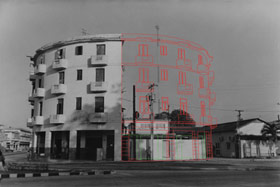
| HOME |
| NERVE |
| REVIEWS |
| ARCHIVE |
| EVENTS |
| LINKS |
| ABOUT US |
| CONTRIBUTORS |
| BACK ISSUES |
| CONTACT US |
 By
Faith and Industry/Overlapping
By
Faith and Industry/Overlapping
Lisa Oppenheim/Carlos Garaicoa
Open Eye Gallery (16th September
– 26th November 2006, Tue-Sat 10:30-17:30, Sun 12-16:00)
Reviewed by Hana Leaper
Lisa Oppenheim’s fascination with archives has led her to the photographer Edward Chambre Hardman’s documentary records of Liverpool. Rather than displaying his images, she uses the accompanying ‘historical’ text with her own ‘contemporary’ images, forging a series of simultaneous and interacting dialogues between past and present (so also future).
This sense of obligation to investigate and incorporate the past can also be found in the writings of Jacques Derrida in his work Spectres of Marx – where he explores the notion that the present owes a moral duty, perhaps a debt, of memory to the past – that in order to shape an ethical future there must be a constant dialogue with the ghosts (the actions and possibilities) of the past. However, we are charged to be careful not to speak over these revenants of the past – but to let them speak for themselves. By reversing the usual documentary processes through which we commemorate (i.e. archive pictures with contemporary text), Oppenheim allows the past to speak over the sites of the present, and absence to make itself heard within presence thereby subverting the genre of portraiture by creating a fluid portrait containing past, present and future. The text itself is also a fluid form, having been taken from not only Hardman’s captions, but the comments that the archive staff added in the margins.
The question is, how successful is this séance in raising spectres, and are the images and narrative convergent or contradictory? Though the theoretical considerations that inspire and feed the piece are absorbing, the work itself is less so. Two projectors set at opposite ends of the second gallery room, project onto screens setup back to back in the centre of the room. On one side, the text is projected, against the background sky of the corresponding image. On the other, the images Oppenheim has chosen are displayed. It is almost impossible for the viewer to link the images and text, which is supposedly to enable the viewer to make new connections between them. This separation leads to a deferral of understanding that is augmented by the chosen text, which relates to images of places now destroyed, i.e. a lake filled in to build housing, demolished buildings. Unfortunately, in practise, this work is not as intriguing as it sounds.
Carlos Garaicoa works with the theory that reality is a palimpsest, a taut surface spread out over and, crucially, crushing down the chaotic cacophony of the ghosts of what have, might have and could be. In other words, we inhabit a façade of singularity and normality, strictly policed by institutions whose interests lie in maintaining the status quo, who paper over any fissures that would allow difference to rise up and manifest itself.
An example of a rupture in the palimpsest would be incidents of the uncanny – inexplicable experiences akin to déjà vu when something is both familiar and unfamiliar (or to be more linguistically precise, ‘homely’ and ‘unhomely’ in the original German). Unfamiliar because social regulatory mechanisms do not allocated it a space, familiar because on some level we know of it.
These works forage in the layer beneath the palimpsest and are uncanny in their resultant eerie un/familiarity. The technique used presents - or makes present - the spectral forms of buildings which previously occupied sites in the city, or raise the spectres of unrealised architectural plans. Garaicoa uses blown up photographs of notable Liverpool landmarks for the first (palimpsestic) layer, then working from archive photographs and plans, overlays them with an outline of connected by threads - achieving a transparent, ghostly effect.
Overlapping (Workhouse) shows the Liverpool Metropolitan Cathedral (monument of civic pride, tourist attraction, venerated place of worship, grand feat of architecture and engineering) consecrated 1967, overlaid by the workhouse that stood on the site between 1727-1928 (site of misery and destitution, hunger, slave labour, sickness and separation).
Overlapping (Anthony Walker’s Corridor) is a comment on contemporary Liverpool society, showing the park where Anthony was murdered shadowed by the pub that used to stand opposite the bus stop from where he was chased.
The exhibition would be greatly helped by clearer labelling of the pieces – it is unclear what some of them are and why Garaicoa has chosen to juxtapose them. We are shown the ghostly coexistence of pride and shame, veneration and degradation, and our own responsibility, as citizens of Liverpool, to our future becomes clear.
To read Mark Langshaw's review of this exhibition click here